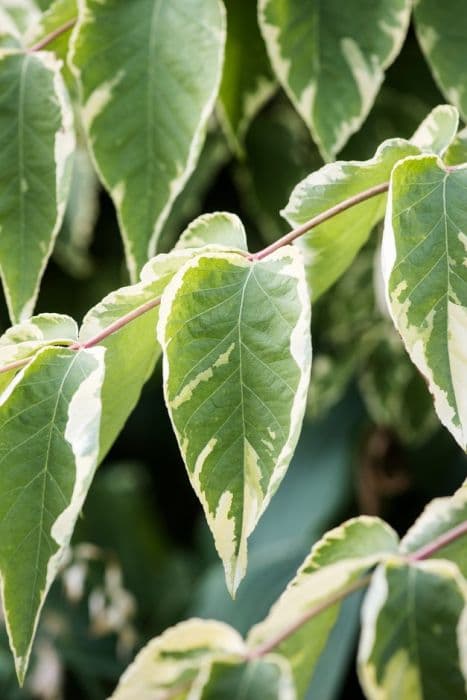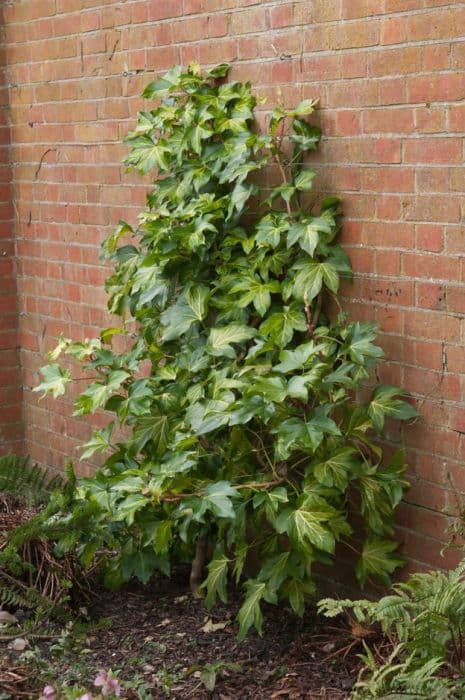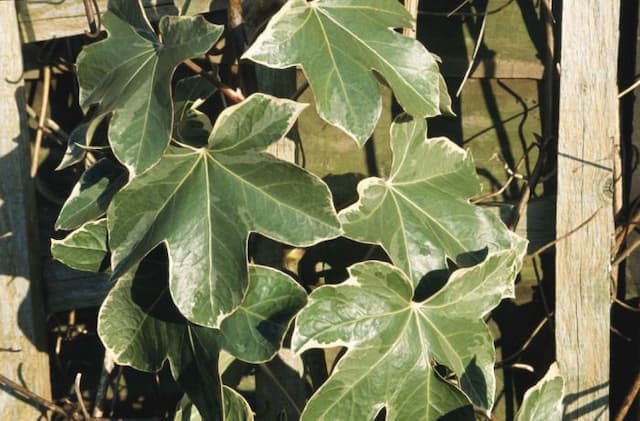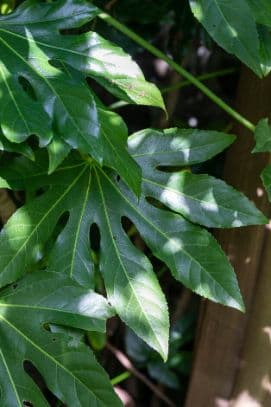English Ivy Hedera helix 'Glacier' (v)

ABOUT
Commonly known as the English ivy 'Glacier', this variant is admired for its decorative foliage. It features leaves that are variegated with patterns of green, white, and gray. The leaves themselves are distinctly shaped with three to five lobes, often with a pronounced central lobe that gives the foliage a somewhat angular appearance. Each leaf is typically glossy, enhancing the variegation and making it stand out under various lighting conditions. Depending on the environment, the edges of the leaves may show a slight waviness, contributing to its lush and textured look. Throughout the seasons, this perennial maintains its evergreen coloration, which makes it an attractive choice for year-round interest in gardens and indoor spaces. As a climber or groundcover, the English ivy 'Glacier' tends to spread horizontally and vertically, attaching itself to surfaces with root-like structures. This ivy is not only known for its ornamental value but also for its adaptability, thriving indoors as a houseplant or outside on walls, fences, and trellises. It is a versatile plant that can add a touch of elegance to both landscapes and interior spaces with its uniquely patterned foliage.
About this plant
 Names
NamesFamily
Araliaceae.
Synonyms
English Ivy, Common Ivy, European Ivy.
Common names
Hedera helix 'Glacier'.
 Toxicity
ToxicityTo humans
English Ivy, when ingested by humans, can be toxic and cause symptoms such as gastrointestinal distress, vomiting, diarrhea, and abdominal pain. The plant also contains compounds that can irritate the skin and mucous membranes, so handling it might lead to dermatitis or other skin irritations. In severe cases, consuming large quantities can result in more serious conditions such as difficulty in breathing, fever, polydipsia (excessive thirst), delirium, hallucinations, convulsions, or even coma. It is therefore advisable to keep English Ivy out of reach of children who might accidentally ingest the plant.
To pets
English Ivy is toxic to pets such as dogs and cats. If a pet ingests parts of the plant, it may exhibit symptoms including vomiting, abdominal pain, hypersalivation, and diarrhea. In severe cases, ingestion can lead to more critical symptoms such as difficulty in breathing, weakness, ataxia (loss of coordination), and occasionally can result in coma or death if left untreated. It is important to prevent pets from having access to English Ivy and to seek veterinary care immediately if ingestion is suspected.
 Characteristics
CharacteristicsLife cycle
Perennials
Foliage type
Evergreen
Color of leaves
Variegated
Height
6-8 feet (1.8-2.4 meters)
Spread
6-8 feet (1.8-2.4 meters)
Plant type
Climber
Hardiness zones
5-9
Native area
Europe
Benefits
 General Benefits
General Benefits- Easy to Grow: Tolerates a variety of conditions and can thrive in different environments without much care.
- Visual Appeal: Adds a decorative touch with its variegated leaves, enhancing the aesthetics of gardens, terraces, and indoor spaces.
- Covers Ground: Excellent for ground cover, effectively suppressing weeds and reducing garden maintenance.
- Vertical Gardening: Climbs walls and structures, which is perfect for creating green facades and saving space.
- Erosion Control: Its root system stabilizes soil and helps to prevent erosion on slopes and banks.
- Seasonal Interest: Retains its foliage all year round, providing greenery throughout the seasons.
- Wildlife Support: Offers habitat and sometimes food for birds and insects, promoting biodiversity.
 Medical Properties
Medical Properties- Expectorant: English ivy may help alleviate symptoms of bronchitis and asthma by loosening mucus.
- Anti-inflammatory: The saponins present in English ivy may reduce swelling and help with conditions such as arthritis.
- Antispasmodic: It has the potential to relieve smooth muscle spasms, possibly aiding those with coughs.
- Antimicrobial: English ivy extracts have shown some antimicrobial activity which might contribute to its use in skin conditions.
- Antioxidant: The plant contains flavonoids and polyphenols that may have antioxidant properties.
- Mucolytic: English ivy may help break down mucus and make it easier to cough up.
 Air-purifying Qualities
Air-purifying QualitiesThis plant is not specifically known for air purifying qualities.
 Other Uses
Other Uses- Topiary Art - English ivy can be sculpted into various shapes to create living art pieces for gardens and landscapes.
- Erosion Control - The dense matting of ivy roots can help to stabilize soil and prevent erosion on slopes or banks.
- Privacy Screening - The vigorous growth of English ivy can be used to create a green privacy screen on fences or walls.
- Sound Barrier - Thick growth of ivy on walls can absorb and reduce noise pollution in urban environments.
- Craft Material - The vines of English ivy can be used for making wreaths or other decorative crafts.
- Covering Unsightly Areas - English ivy can camouflage and beautify areas like compost heaps, or unsightly walls and fences.
- Zoo Habitat Enrichment - The plants can be used to recreate naturalistic environments for certain animals in zoos.
- Urban Wildlife Support - Provides shelter and sometimes berries for birds and other urban wildlife within its growth.
- Photography Backdrop - The intricate patterns of English ivy leaves can serve as a natural backdrop for photographers.
- Film and Theatre - Used as a set decoration to create an aged or natural look in film and theatre productions.
Interesting Facts
 Feng Shui
Feng ShuiThe English Ivy is not used in Feng Shui practice.
 Zodiac Sign Compitability
Zodiac Sign CompitabilityThe English Ivy is not used in astrology practice.
 Plant Symbolism
Plant Symbolism- Friendship and Affection: Commonly known as English Ivy, Hedera helix 'Glacier' often symbolizes strong emotional bonds. The plant's tendency to cling to surfaces powerfully and persistently is reminiscent of the clinging nature of love and friendship.
- Fidelity: English Ivy's evergreen quality makes it a symbol of fidelity and long-lasting relationships. Its perennial nature represents the constancy and reliability one can expect in a committed partnership.
- Eternal life: The ivy's ability to remain green throughout the year has long been associated with immortality and eternal life in various cultures.
- Protection: Historically, English Ivy was often believed to protect against evil spirits and negative energy, possibly due to its enclosing, intertwining growth habit which could be seen as forming a protective barrier.
- Prosperity: Due to its vigorous growth, ivy is also a symbol of prosperity and abundance. It suggests that whatever it touches will grow and flourish profusely.
- Intellectual Growth: The plant's propensity to climb toward the light is sometimes paralleled with the pursuit of knowledge and the growth of the intellect.
 Water
WaterEnglish Ivy 'Glacier' prefers consistent moisture, but it's essential to let the top inch of soil dry out before watering again, which typically means watering once every 7 to 10 days. The amount of water needed will depend on the size of the plant; for a medium-sized ivy in a 10-inch pot, use roughly 16 ounces of water each time you water. Ensure you water the plant at the base and avoid wetting the leaves to prevent fungal diseases. Monitor your ivy during the heat of summer and in dry indoor conditions in winter, as it may need more frequent watering.
 Light
LightEnglish Ivy 'Glacier' thrives in bright, indirect light but can also adapt to low-light conditions. Avoid direct sunlight as it can scorch the leaves. The best spot for English Ivy is near a window that gets morning light or filtered light throughout the day, with protection from intense afternoon sun.
 Temperature
TemperatureEnglish Ivy 'Glacier' prefers cool to moderate temperatures and can survive in a range between 50°F and 70°F. It's essential to protect the plant from temperature extremes, with minimum winter temperatures not dropping below 50°F and summers ideally not exceeding 70°F, as extreme heat can stress the plant.
 Pruning
PruningPruning English Ivy 'Glacier' is necessary to maintain its shape, encourage bushier growth, and remove any dead or damaged foliage. Prune as needed throughout the year, but the best time for a significant trim is in spring before new growth starts. You can give the ivy a light prune whenever it appears to be getting too leggy or overgrown.
 Cleaning
CleaningAs needed
 Soil
SoilEnglish Ivy 'Glacier' prefers a well-draining soil mix with a slight acidic to neutral pH between 6.0 to 7.5. A mix of peat, perlite, and garden loam in equal parts fosters healthy growth.
 Repotting
RepottingEnglish Ivy 'Glacier' should be repotted every two to three years to refresh the soil and accommodate root growth.
 Humidity & Misting
Humidity & MistingEnglish Ivy 'Glacier' thrives best in moderate to high humidity levels, ideally between 40% to 70%.
 Suitable locations
Suitable locationsIndoor
Provide bright, indirect light and keep evenly moist.
Outdoor
Choose shaded area, water regularly, protect from frost.
Hardiness zone
5-11 USDA
 Life cycle
Life cycleThe English Ivy 'Glacier' (Hedera helix 'Glacier') begins its life cycle as a seed, which germinates in moist, fertile soil in partial to full shade. Upon sprouting, it enters the juvenile vegetative stage, characterized by rapid growth and the development of its distinct variegated leaves. During this stage, English Ivy grows as a ground cover or climbs surfaces with its aerial rootlets. After several years, it may reach maturity and enter the adult vegetative stage, where the leaves become less lobed, and it develops the ability to flower. Blooming occurs in late summer to fall, producing small, inconspicuous flowers that are attractive to bees and other pollinators. Following successful pollination, it produces clusters of dark berries which, once ripe, can be dispersed by birds, enabling the cycle to begin anew with the germination of new seeds.
 Propogation
PropogationPropogation time
Spring to Summer
Propogation: The English Ivy 'Glacier' is typically propagated through stem cuttings. The best time to propagate this plant is in the spring or early summer when the plant is actively growing. To do so, you would take a stem cutting that is about 4 to 6 inches (10 to 15 cm) long, ensuring it has several leaves. Remove the lower leaves, then dip the cut end into rooting hormone powder to increase the odds of successful rooting. The cutting can be planted into a pot filled with a mix of half peat and half perlite or sand to provide good drainage. It's important to keep the soil moist but not waterlogged and to place the pot in an area with bright, indirect light. Roots typically develop in a few weeks, after which the new ivy plant can be transplanted if needed.









